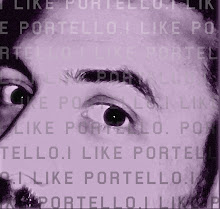Last Friday night Budge and I went to see a play called Ying Tong. And as it's been a slack weekend, I haven't gotten around to writing about it until now.
The play is based on the history of The Goon Show. For the benefit of those living under rocks in caves with their fingers in their ears, The Goon Show was the 1950s BBC radio comedy that introduced the world to Harry Secombe, Peter Sellers and the one and only Spike Milligan.
The story of Ying Tong (the title being a reference to the Goon song "Ying-tong-iddle-i-po") is centred around Spike, who is credited for writing the bulk of the Goon Show episodes. The story takes place variously in a recording session for an episode of the show, in the psychiatric hospital where Milligan was having one of his many nervous breakdowns, and in a surreal Goon-like world in which Milligan is visited by characters from the show, as well as their later incarnations, such as Sellers' Dr Strangelove.
It's a very strange play in a lot of ways, with nonlinear storytelling reminiscent of the Goon Show's famous lack of structure and stream-of-consciousness rambling. This was presumably deliberate. Much of the play is done in flashback, with the implication that we are seeing scenes of Milligan's drug-induced hallucinations while hospitalised. The visions range from simple recollections of conversations with Sellers and Secombe, to psychedelic visions of leprechauns and morris dancers. Yes really.
It's all done in a very post-modern way, though, with Milligan pointing out when another flashback is coming on, and Secombe and Sellers making constant reference to their imaginary status.
The play is mainly concerned with Milligan's breakdown towards the end of the show's run, and the impact it has on his marriage, his friends and his work. But through all this, we actually learn very little about the man himself. There's a lot of history bundled into a reasonably short piece, but it's all the stuff of public record, such as Milligan's war service, his injury and (first) breakdown, meeting with Secombe and Sellers and the pressures of writing the show. As a big fan of the Goons, I got a kick out seeing these things recreated, but I didn't learn anything new.
What surprised me was the quality of the performances. A couple of times I got so immersed in it that I imagined I was watching the real Milligan, Secombe and Sellers. For Jonathan Biggins, playing Sellers, this was particularly extraordinary. Biggins managed to pull out flawless renditions of many of Sellers' famous characters including Bluebottle, Crun, Grytpype-Thynne, Major Bloodnok, Dr Strangelove and Inspector Clouseau. The other actors also handled their complex, and occasionally frenetic, roles very well.
In summary, it's a must for fans of The Goon Show and (probably) very enjoyable for those unfamiliar with it.
Now, if you happen to be one of these unfortunates who are unfamiliar with it, then take my advice, and sit down and listen to a couple of episodes. Preferably three of four.
The first one will seem very strange, somewhat incomprehensible, and you won't find it funny at all. Sometime during the second episode you'll begin to get into the rhythm of the show, and it might raise a giggle or two. The third will have have you in stitches and by the end of the fourth you'll be ready to strap on your chocolate euphonium, don your extra-strength knees and join the Goon parade.



0 comments:
Post a Comment